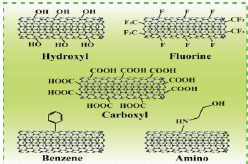Carbon Nanotubes for Thermal Therapy CNTs: Effect of Nanotube Structure and Doping on Photothermal Properties, Anticancer Efficacy of CNT-Enhanced PTT and Systemic Delivery and Biocompatibility of CNTs for PTT
Keywords:
Carbon Nanotubes, Thermal Therapy, Doping, Photothermal Properties, AnticancerAbstract
From manufacturing to health-related therapies, nanotechnology is causing a revolution in many different sectors. The remarkable mechanical, electrical, and physicochemical characteristics of carbon nanotubes (CNTs) have made them an attractive medicinal prospect in the field of nanomedicine. An increase in therapeutic efficacy or a decrease in toxicities of medicinally active substances is the primary motivation for creating nanocarrier drug delivery systems. Traditional methods involve the use of liposomes and other spherically shaped vesicle nanocarriers to accomplish this. As an alternative, carbon nanotubes (CNTs) are basically just carbon atoms arranged in a cylindrical shape. Carbon nanotubes (CNTs) are continuous graphene sheets wound into a cylinder with a high aspect ratio, a diameter of less than 1 nm, and a length of several micrometres. The cylinders can be open-ended or capped. Multiwalled carbon nanotubes (MWNTs) are composed of multiple graphene sheets, whereas single-walled nanotubes (SWNTs) are formed by CNTs manufactured from a single sheet of graphene. Biomedical uses of CNTs were not possible until methods to make them soluble and functionalized them with organic groups were developed. They can absorb or conjugate with many different medicinal compounds because of their large surface area. A new carrier system for both large and small medicinal compounds, carbon nanotubes (CNTs) have only lately been introduced. To control their biological or physical characteristics, CNTs can be surface-engineered with certain functional groups, a process known as functionalization. In addition to their versatility as therapeutic chemical carriers, carbon nanotubes (CNTs) have found usage in photothermal cell death because to their enormous surface area and the ease with which their physical dimensions and surfaces may be controlled.
Downloads
References
Donaldson, K., F. Murphy et al. 2011. Identifying the pulmonary hazard of high aspect ratio nanoparticles to enable their safety-by-design. Nanomedicine (London) 6(1):143–156.
Robinson, J. T., K. Welsher et al. 2010. High performance in vivo near-IR (>1 mum) imaging and photothermal cancer therapy with carbon nanotubes. Nano Research 3(11): 779–793.
Ruenraroengsak, P., J. M. Cook et al. 2010. Nanosystem drug targeting: Facing up to complex realities. Journal of Controlled Release 141(3):265–276.
Dresselhaus, M. S. 2004. Applied physics: Nanotube antennas. Nature 432(7020):959–960.
Ajayan, P. M., M. Terrones et al. 2002. Nanotubes in a flash— ignition and reconstruction. Science 296(5568):705.
Ananta, J. S., B. Godin et al. 2010. Geometrical confinement of gadolinium-based contrast agents in nanoporous particles enhances T(1) contrast. Nature Nanotechnology 5(11):815–821.
Stella, G. M. 2011. Carbon nanotubes and pleural damage: Perspectives of nanosafety in the light of asbestos experience. Biointerphases 6(2):P1–P17.
Stoyanov, S. R., A. V. Titov et al. 2009. Transition metal and nitro- gen doped carbon nanostructures. Coordination Chemistry Reviews 253(23–24):2852–2871.
Talanov, V. S., C. A. Regino et al. 2006. Dendrimer-based nano- probe for dual modality magnetic resonance and fluorecence imaging. Nano Letters 6(7):1459–1463.
Ayala, P., R. Arenal et al. 2010. The physical and chemical properties of heteronanotubes. Reviews of Modern Physics 82(2):1843–1885.
Bao, S., Q. Wu et al. 2006. Glioma stem cells promote radio- resistance by preferential activation of the DNA damage response. Nature 444(7120):756–760.
Berber, S., Y. K. Kwon et al. 2000. Unusually high thermal conductivity of carbon nanotubes. Physical Review Letters 84(20):4613–4616.
Bergamaschi, D., M. Gasco et al. 2003. p53 polymorphism influences response in cancer chemotherapy via modulation of p73-dependent apoptosis. Cancer Cell 3(4):387–402.
Bhirde, A. A., S. Patel et al. 2010. Distribution and clearance of PEG-single-walled carbon nanotube cancer drug delivery vehicles in mice. Nanomedicine 5(10):1535–1546.
Esfarjani, K., A. A. Farajian et al. 1999. Electronic and transport properties of N-P doped nanotubes. Applied Physics Letters 74(1):79–81.
Falk, M. H., and R. D. Issels. 2001. Hyperthermia in oncology. International Journal of Hyperthermia 17(1):1–18.
Biris, A. S., D. Boldor et al. 2009. Nanophotothermolysis of multiple scattered cancer cells with carbon nanotubes guided by time-resolved infrared thermal imaging. Journal of Biomedical Optics 14(2):021007.
Brannon-Peppas, L., and J. O. Blanchette. 2004. Nanoparticle and targeted systems for cancer therapy. Advanced Drug Delivery Reviews 56(11):1649–1659.
Brigger, I., C. Dubernet et al. 2002. Nanoparticles in cancer therapy and diagnosis. Advanced Drug Delivery Reviews 54(5):631–651.
Burke, A., X. Ding et al. 2009. Long-term survival following a single treatment of kidney tumors with multiwalled carbon nanotubes and near-infrared radiation. Proceedings of the National Academy of Sciences of the United States of America 106(31):12897–12902.
Burke, A. R., R. N. Singh et al. 2011. Determinants of the throm- bogenic potential of multiwalled carbon nanotubes. Biomaterials 32(26):5970–5978.
Burke, A. R., R. N. Singh et al. 2012. The resistance of breast cancer stem cells to conventional hyperthermia and their sensitivity to nanoparticle-mediated photothermal therapy. Biomaterials 33(10):2961–2970.
Chen, W. R., M. Korbelik et al. 2005. Enhancement of laser cancer treatment by a chitosan-derived immunoadjuvant. Photochemistry and Photobiology 81(1):190–195.
Dai, H. 2002. Carbon nanotubes: Synthesis, integration, and properties. Accounts of Chemical Research 35(12):1035–1044.
Day, E. S., J. G. Morton et al. 2009. Nanoparticles for thermal cancer therapy. Journal of Biomechanical Engineering- Transactions of the Asme 131(7):074001.
Deng, X. Y., F. Wu et al. 2009. The splenic toxicity of water soluble multi-walled carbon nanotubes in mice. Carbon 47(6):1421–1428.
Diehn, M., and M. F. Clarke. 2006. Cancer stem cells and radio- therapy: New insights into tumor radioresistance. Journal of the National Cancer Institute 98(24):1755–1757.
Ding, X., R. Singh et al. 2011. Development of iron-containing multiwalled carbon nanotubes for MR-guided laser-induced thermotherapy. Nanomedicine (London) 6(8):1341–1352.
Dobrovolskaia, M. A., P. Aggarwal et al. 2008. Preclinical studies to understand nanoparticle interaction with the immune system and its potential effects on nanoparticle biodistribution. Molecular Pharmaceutics 5(4):487–495.
Doherty, S. P., D. B. Buchholz et al. 2006. Semi-continuous production of multiwalled carbon nanotubes using magnetic field assisted arc furnace. Carbon 44(8):1511–1517.
Donaldson, K., R. Aitken et al. 2006. Carbon nanotubes: A review of their properties in relation to pulmonary toxicology and workplace safety. Toxicology Science 92(1):5–22.
Dresselhaus, M. S., G. Dresselhaus et al. 1995. Physics of carbon nanotubes. Carbon 33(7):883–891.
Dumitrica, T., M. E. Garcia et al. 2004. Selective cap opening in carbon nanotubes driven by laser-induced coherent phonons. Physical Review Letters 92(11):117401.
Dyke, C. A., and J. M. Tour. 2004. Overcoming the insolubility of carbon nanotubes through high degrees of sidewall functionalization. Chemistry 10(4):812–817.
Sayes, C. M., F. Liang et al. 2006. Functionalization density dependence of single-walled carbon nanotubes cytotoxicity in vitro. Toxicology Letters 161(2):135–142.
Schipper, M. L., N. Nakayama-Ratchford et al. 2008. A pilot toxi- cology study of single-walled carbon nanotubes in a small sample of mice. Nature Nanotechnology 3(4):216–221.
Schonenberger, C., and L. Forro. 2000. Mulitwall carbon nano- tubes. Physics World 13:37 41.
Feazell, R. P., N. Nakayama-Ratchford et al. 2007. Soluble single-walled carbon nanotubes as longboat delivery systems for platinum(IV) anticancer drug design. Journal of the American Chemical Society 129(27):8438–8439.
Fisher, J. W., S. Sarkar et al. 2010. Photothermal response of human and murine cancer cells to multiwalled carbon nanotubes after laser irradiation. Cancer Research 70(23): 9855–9864.
Fujii, M., X. Zhang et al. 2005. Measuring the thermal conductivity of a single carbon nanotube. Physics Review Letters 95(6):065502.
Gannon, C. J., P. Cherukuri et al. 2007. Carbon nanotube- enhanced thermal destruction of cancer cells in a noninvasive radiofrequency field. Cancer 110(12):2654–2665.
Ge, Z. B., Y. J. Kang et al. 2005. Thermal transport in Au-core polymer–shell nanoparticles. Nano Letters 5(3):531–535.
Geohegan, D. B., A. A. Puretzky et al. 2007. In situ time-resolved measurements of carbon nanotube and nanohorn growth. Physica Status Solidi (B) 244(11):3944–3949.
Kempa, K. 2002. Gapless plasmons in carbon nanotubes and their interactions with phonons. Physical Review B66(19): 195406–195410.
Keren, K., R. S. Berman et al. 2003. DNA-templated carbon nano-tube field-effect transistor. Science 302(5649):1380–1382.
Kim, K. Y. 2007. Nanotechnology platforms and physiological challenges for cancer therapeutics. Nanomedicine 3(2):103–110.
Ghosh, S., S. Dutta et al. 2009. Increased heating efficiency and selective thermal ablation of malignant tissue with DNA-encased multiwalled carbon nanotubes. ACS Nano 3(9):2667–2673.
Gnyawali, S. C., Y. Chen et al. 2008. Temperature measurement on tissue surface during laser irradiation. Medical & Biological Engineering & Computing 46(2):159–168.
Gottesman, M. M. 2002. Mechanisms of cancer drug resistance. Annual Review of Medicine 53(1):615–627.
Hagen, A., G. Moos et al. 2004. Electronic structure and dynamics of optically excited single-wall carbon nanotubes. Applied Physics A Materials Science & Processing 78(8):1137–1145.
Kostarelos, K., L. Lacerda et al. 2007. Cellular uptake of functionalized carbon nanotubes is independent of functional group and cell type. Nature Nanotechnol 2(2):108–113.
Kostarelos, K., A. Bianco et al. 2009. Promises, facts and challenges for carbon nanotubes in imaging and therapeutics. Nature Nanotechnol 4(10):627–633.
Hanson, G. W. 2005. Fundamental transmitting properties of car- bon nanotube antennas. Ieee Transactions on Antennas and Propagation 53(11):3426–3435.
Hartland, G. V., M. Hu et al. 2004. Investigation of the properties of gold nanoparticles in aqueous solution at extremely high lattice temperatures. Chemical Physics Letters 391(4–6): 220–225.
Hartman, K. B., S. Laus et al. 2008. Gadonanotubes as ultra- sensitive pH-smart probes for magnetic resonance imaging. Nano Letters 8(2):415–419.
Hata, K., D. N. Futaba et al. 2004. Water-assisted highly efficient synthesis of impurity-free single-walled carbon nanotubes. Science 306(5700):1362–1364.
Hone, J. 2000. Electrical and thermal transport properties of magnetically aligned single wall carbon nanotube films. Applied Physics Letters 77(5):666.
Imholt, T. J., C. A. Dyke et al. 2003. Nanotubes in microwave fields: Light emission, intense heat, outgassing, and reconstruction. Chemistry of Materials 15(21):3969–3970.
Javey, A., J. Guo et al. 2003. Ballistic carbon nanotube field-effect transistors. Nature 424(6949):654–657.
Jia, G., H. F. Wang et al. 2005. Cytotoxicity of carbon nanomaterials: Single-wall nanotube, multi-wall nanotube, and fullerene. Environmental Science & Technology 39(5): 1378–1383.
Jordan, C. T., M. L. Guzman et al. 2006. Cancer stem cells. New England Journal of Medicine 355(12):1253–1261.
Kaiser, J. P., M. Roesslein et al. 2011. Carbon nanotubes — curse or blessing. Current Medicinal Chemistry 18(14): 2115–2128.
Kam, N. W., and H. Dai. 2005. Carbon nanotubes as intra- cellular protein transporters: Generality and biological functionality. Journal of the American Chemical Society 127(16):6021–6026.
Kam, N. W., M. O’Connell et al. 2005. Carbon nanotubes as multi- functional biological transporters and near-infrared agents for selective cancer cell destruction. Proceedings of the National Academy of Sciences of the United States of America 102(33):11600–11605.
Kamen, B. A., and A. K. Smith. 2004. A review of folate receptor alpha cycling and 5-methyltetrahydrofolate accumulation with an emphasis on cell models in vitro. Advanced Drug Delivery Reviews 56(8):1085–1097.
Kanemitsu, Y. 2011. Excitons in semiconducting carbon nano- tubes: Diameter-dependent photoluminescence spectra. Physical Chemistry Chemical Physics 13(33):14879–14888.
Keblinski, P., D. G. Cahill et al. 2006. Limits of localized heat- ing by electromagnetically excited nanoparticles. Journal of Applied Physics 100(5):054305–054309.
Kim, P., L. Shi et al. 2001. Thermal transport measurements of individual multiwalled nanotubes. Physics Review Letters 87(21):215502.
Klingeler, R., S. Hampel et al. 2008. Carbon nanotube based biomedical agents for heating, temperature sensoring and drug delivery. International Journal of Hyperthermia 24(6):496–505.
Kolosnjaj, J., H. Szwarc et al. 2007. Toxicity studies of carbon nanotubes. Bio-Applications of Nanoparticles 620:181–204.
Kong, L. B., S. Li et al. 2010. Electrically tunable dielectric materials and strategies to improve their performances. Progress in Materials Science 55(8):840–893.
Konig, K. 2000. Multiphoton microscopy in life sciences. Journal of Microscopy 200(Pt 2):83–104.
Kostarelos, K. 2008. The long and short of carbon nanotube toxicity. Nature Biotechnology 26(7):774–776.
Koyama, S., Y. A. Kim et al. 2009. In vivo immunological toxicity in mice of carbon nanotubes with impurities. Carbon 47(5):1365–1372.
Kratz, F. 2010. Albumin, a versatile carrier in oncology. International Journal of Clinical Pharmacology and Therapeutics 48(7): 453–455.
Lacerda, L., A. Bianco et al. 2006. Carbon nanotubes as nanomedicines: From toxicology to pharmacology. Advanced Drug Delivery Reviews 58(14):1460–1470.
Lam, C. W., J. T. James et al. 2006. A review of carbon nanotube toxicity and assessment of potential occupational and environmental health risks. Critical Reviews in Toxicology 36(3):189–217.
Leamon, C. P., and J. A. Reddy. 2004. Folate-targeted chemotherapy. Advanced Drug Delivery Reviews 56(8):1127–1141.
Lee, J., S. Kotliarova et al. 2006. Tumor stem cells derived from glioblastomas cultured in bFGF and EGF more closely mirror the phenotype and genotype of primary tumors than do serum-cultured cell lines. Cancer Cell 9(5):391–403.
Lehman, J. H., M. Terrones et al. 2011. Evaluating the characteristics of multiwall carbon nanotubes. Carbon 49(8): 2581–2602
Reulet, B., A. Y. Kasumov et al. 2000. Acoustoelectric effects in car- bon nanotubes. Physical Review Letters 85(13):2829–2832.
Richard, C., B. T. Doan et al. 2008. Noncovalent functionalization of carbon nanotubes with amphiphilic Gd3+ chelates: Toward powerful T-1 and T-2 MRI contrast agents. Nano Letters 8(1):232–236.
Rieke, V., and K. B. Pauly. 2008. MR thermometry. Journal of Magnetic Resonance Imaging 27(2):376–390.
Ryman-Rasmussen, J. P., E. W. Tewksbury et al. 2009. Inhaled multiwalled carbon nanotubes potentiate airway fibrosis in murine allergic asthma. American Journal of Respiratory Cell and Molecular Biology 40(3):349–358.
Saito, R., M. Hofmann et al. 2011. Raman spectroscopy of graphene and carbon nanotubes. Advances in Physics 60(3):413–550.
Saito, Y., K. Hata et al. 2002. Field emission of carbon nanotubes and its application as electron sources of ultra-high luminance light-source devices. Physica B-Condensed Matter 323(1–4):30–37.
Salvador-Morales, C., W. W. Gao et al. 2009. Multifunctional nanoparticles for prostate cancer therapy. Expert Review of Anticancer Therapy 9(2):211–221.
Selvi, B. R., D. Jagadeesan et al. 2008. Intrinsically fluorescent carbon nanospheres as a nuclear targeting vector: Delivery of membrane-impermeable molecule to modulate gene expression in vivo. Nano Letters 8(10):3182–3188.
Semberova, J., S. H. De Paoli Lacerda et al. 2009. Carbon nano-tubes activate blood platelets by inducing extracellular Ca2+ influx sensitive to calcium entry inhibitors. Nano Letters 9(9):3312–3317.
Beg, S., M. Rizwan et al. 2011. Advancement in carbon nano- tubes: Basics, biomedical applications and toxicity. Journal of Pharmacy and Pharmacology 63(2):141–163.
Beier, D., J. Wischhusen et al. 2008. CD133 Expression and cancer stem cells predict prognosis in high-grade oligodendroglial tumors. Brain Pathology 18(3):370–377.
Shi Kam, N. W., T. C. Jessop et al. 2004. Nanotube molecular transporters: Internalization of carbon nanotube–protein conjugates into Mammalian cells. Journal of the American Chemical Society 126(22):6850–6851.
Shvedova, A. A., E. R. Kisin et al. 2005. Unusual inflammatory and fibrogenic pulmonary responses to single-walled carbon nanotubes in mice. American Journal of Physiology-Lung Cellular and Molecular Physiology 289(5): L698–L708.
Singh, R., D. Pantarotto et al. 2005. Binding and condensation of plasmid DNA onto functionalized carbon nanotubes: Toward the construction of nanotube-based gene delivery vectors. Journal of the American Chemical Society 127(12): 4388–4396.
Biris, A. R., S. Ardelean et al. 2011. Studies on near infrared optical absorption, Raman scattering, and corresponding thermal properties of single- and double-walled carbon nanotubes for possible cancer targeting and laser-based ablation. Carbon 49(13):4403–4411.
Ebbesen, T. W., and P. M. Ajayan. 1992. Large-scale synthesis of carbon nanotubes. Nature 358(6383):220–222.
blood clearance rates of intravenously administered car- bon nanotube radiotracers. Proceedings of the National Academy of Sciences of the United States of America 103(9): 3357–3362.
Singh, S. K., C. Hawkins et al. 2004. Identification of human brain tumour initiating cells. Nature 432(7015):396–401.
Sitharaman, B., K. R. Kissell et al. 2005. Superparamagnetic gadonanotubes are high-performance MRI contrast agents. Chemical Communications (31):3915–3917.
Kang, B., D. Yu et al. 2009. Cancer-cell targeting and photoacoustic therapy using carbon nanotubes as bomb agents. Small 5(11):1292–1301.
Kangasniemi, M., R. J. McNichols et al. 2004. Thermal therapy of canine cerebral tumors using a 980 nm diode laser with MR temperature-sensitive imaging feedback. Lasers in Surgery and Medicine 35(1):41–50.
Smart, S. K., A. I. Cassady et al. 2006. The biocompatibility of car- bon nanotubes. Carbon 44(6):1034–1047.
Tasis, D., N. Tagmatarchis et al. 2003. Soluble carbon nanotubes. Chemistry-A European Journal 9(17):4001–4008.
Terrones, M., A. G. Souza et al. 2008. Doped carbon nanotubes: Synthesis, characterization and applications. Carbon Nanotubes 111:531–566.
Torti, S. V., F. Byrne et al. 2007. Thermal ablation therapeutics based on CN(x) multi-walled nanotubes. Int J Nanomedicine 2(4):707–714

Downloads
Published
How to Cite
Issue
Section
License

This work is licensed under a Creative Commons Attribution 4.0 International License.
Current Clinical and Medical Education













